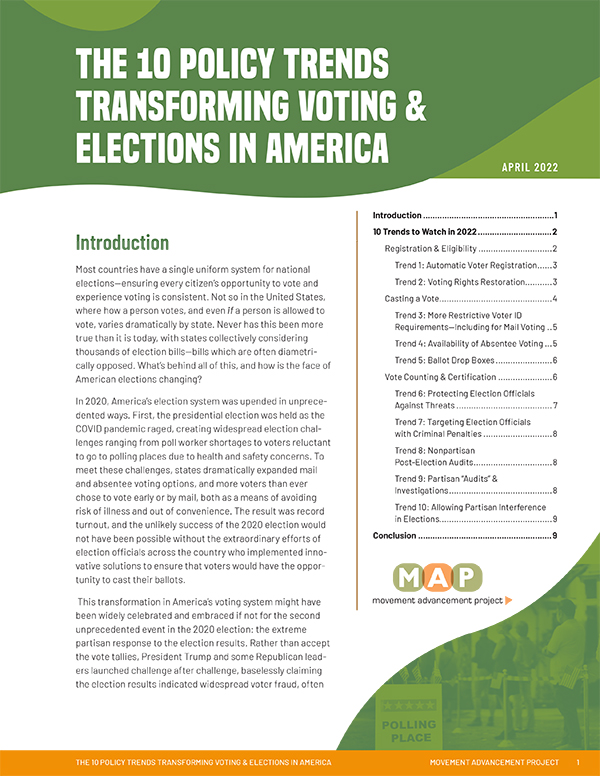The 10 Policy Trends Transforming Voting & Elections in AmericaDownload
The 10 Policy Trends Transforming Voting and Elections in America examines a number of legislative proposals across the United States that seek to make policy changes in three main areas: registration & eligibility, casting a vote, and vote counting & certification. The report is part of MAP’s
Democracy Maps project, which tracks more than 40 laws and policies related to voting and elections.
The report explores the ways that state legislatures are considering diametrically opposed approaches to policy changes related to voting and elections. The 2020 election transformed options for mail and absentee voting, in large part as a result of the pandemic, which enabled a record voter turnout. However, some politicians used the new systems as part of their rationale for launching false claims about voter fraud. Some states are embracing the changes that allowed for record democratic participation, and other states are seeking to undo the changes and further restrict voting access.
In 2022 alone, state legislatures are considering thousands of voting-related bills. While most other democracies have a single voting system for national elections to ensure equal access to voting, America’s voting systems differ dramatically by state—and those differences are growing sharply.
Registration & EligibilityRegistration and eligibility to vote are the starting points in the cycle of an election, and accurate and updated voter lists are one of the most important steps to running a successful election.
- Trend 1, Automatic Voter Registration: At least 13 states are considering bills related to automatic voter registration (AVR), with the majority of proposals intending to newly enact or improve their AVR systems, and at least one state looking to restrict AVR.
- Trend 2,
Voting Rights Restoration: At least 13 states are considering legislation related to restoration of voting rights for people who were formerly incarcerated.
Casting a VoteThe 2020 election saw a dramatic change in this area as more voters than ever chose to cast their ballot through voting by mail and ballot drop boxes — in large part due to pandemic-related policy changes.
- Trend 3, More Restrictive Voter ID Requirements — Including for Mail Voting: At least 13 states are considering legislation related to ID requirements for voting, with almost all of these states looking to make requirements stricter.
- Trend 4, Availability of Absentee Voting: At least 13 states are considering legislation relating to the availability of absentee voting. Some states proposing to restrict these voting options while other states are seeking to carry forward reforms made during the pandemic.
- Trend 5, Ballot Drop Boxes: At least 10 states are considering legislation related to ballot drop boxes, a policy that was noncontroversial before the 2020 election cycle. Multiple states are proposing to restrict or even entirely ban this secure method of voting.
Vote Counting & CertificationIn the past, these processes have been the province of experienced, nonpartisan election officials, but they are now becoming increasingly politicized.
- Trend 6, Protecting Election Officials Against Threats: At least nine states are considering legislation to protect election officials from an alarming rise in threats by increasing penalties for harassment and intimidation of these officials.
- Trend 7, Targeting Election Officials with Criminal Penalties: In contrast to the trend of protecting election officials from threats, at least seven states are considering bills to impose undue criminal penalties against election officials for minor mistakes or technical errors.
- Trend 8, Nonpartisan Post-Election Audits: At least eight states are considering new provisions for nonpartisan, legitimate post-election audits that are a best practice and increase voter confidence in election results.
- Trend 9, Partisan “Audits” and Investigations: At least 13 states are considering bills relating to either retrospective investigations of the 2020 election or legislation to make illegitimate partisan “audits” easier in the future.
- Trend 10, Allowing Partisan Interference in Elections: At least eight states are considering legislation that would increase the power of partisan actors to interfere in election administration.
When the record voter turnout during the 2020 election led to President Trump’s defeat, rather than accept the results, many elected officials launched challenge after challenge, falsely citing voter fraud and blaming many of election changes. As a result, some states are looking to permanently adopt or even expand the changes that allowed more of their citizens to vote during the COVID pandemic, while other states are looking to eliminate them or make their election systems more restrictive.
Recommended citation:
Movement Advancement Project. April 2022. The 10 Policy Trends Transforming Voting & Elections in America.
www.mapresearch.org/2022-report-leg-trends. [Date of access].


